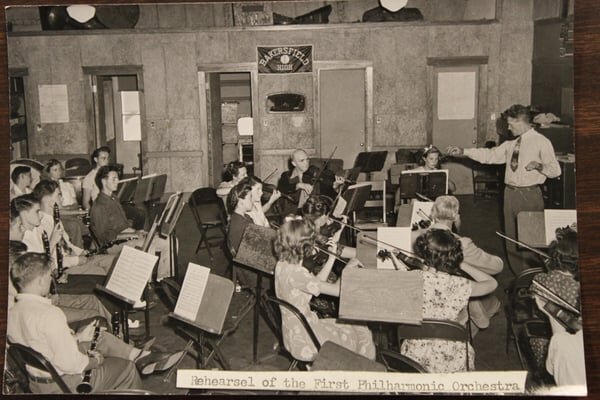A History of the Bakersfield Symphony Orchestra:
The Story of A Community Treasure by Jerome S. Kleinsasser
Beginning in 1932 with a nucleus of determined, dedicated and talented individuals, and expanding over decades into the multi-faceted organization it is today, the existence of the Bakersfield Symphony Orchestra is at once a tribute both to the individual contributions of its many players and to the community it serves. Further, the Orchestra is a manifestation of the ineffable power of music to foster and make tangible the highest ideals and spirit of that community.
Early in the 20th century, concert music in Bakersfield was restricted largely to churches and, to some extent, the community high school. In addition, occasional touring performers traveling between Los Angeles and San Francisco held forth for an evening or two at the opera house. By 1930, a remarkable number of individuals established music studios in their homes, teaching piano, violin or the voice. Notices proudly announcing these offerings liberally peppered the social pages of Bakersfield newspapers.
A concert series hosted by the Music Club at Kern County Union High School regularly attracted audiences to hear local performers and guest artists from as far away as Los Angeles. The Kern Junior College string quartet, led by violin instructor Allan B. Parker, appeared regularly in the community and toured annually to the coast and Los Angeles areas.
At a piano recital one evening in January of 1932, Kathryn McMahan, student president of the High School Musician’s Club, undoubtedly prompted by high school director Harold J. Burt, announced that the club’s concert series for 1932-33 would include a concert by a symphony orchestra drawn from members of the community. Enthusiasm for the idea grew quickly, and a month later the plan included a series of three concerts. Negotiations were already under way to host esteemed pianist Olga Steeb, Canadian violinist Kathleen Parlow, and tenor Fred Scott of the San Francisco opera as soloists. (Due to a change in Scott’s performance schedule, only two of the proposed concerts materialized.) The enterprise created quite a stir, and soon a Bakersfield Californian editorial encouraged the community to get behind the project in order to “relieve the musically parched condition locally.”
As school got under way the following fall, Harold J. Burt, then in his 12th year as director of the high school orchestra, issued a call for musicians to attend the first rehearsal of a community orchestra on September 19 in the school music building. Burt planned an ambitious repertoire for the group, with music by Wagner, Schubert, Haydn, Berlioz and Mendelssohn. Nearly 50 players turned out, more than a few of whom came from as far as Delano and Taft. Fifteen additional players joined a week later.
Harold J. Burt
Performed at the high school, the inaugural concert of the Bakersfield Community Orchestra occurred on November 22, 1932. The enthusiastic Californian declared the orchestra “achieved a triumph for itself… in initiating a local audience into symphonic music literature.” In her detailed account, reviewer Mae Saunders wrote:
Too much praise cannot be lavished upon the director and the musicians for their enterprise and energy in organizing the orchestra, which music lovers of the community sincerely hope may be made a permanent organization. Last night’s performance is only indicative of what may be accomplished in the future musically in the community.
The orchestra, while not yet a perfect ensemble and enriched last night by the importation of several musicians from the south, is in no way a musical makeshift, but an organization to which the community might well point with pride.
The “Bakersfield Symphony Orchestra” officially came into existence on April 17, 1933, when the players assembled, formally adopted that name, elected officers, and declared themselves a permanent organization. A supportive editorial in the Californian stated, “With the making of the orchestra into a permanent organization, it is hoped by music lovers of the community that it will strike roots into the artistic life of the city.” For the next eight years, under the direction of Harold J. Burt, the determined group presented two ambitious concerts every season.
Much changed across America after December 7, 1941, as the nation’s attention turned to the war effort. Facing daunting odds, director Burt valiantly strove to keep the organization functional in very trying times. In January of 1942, the orchestra presented a lengthy concert that included Dvorak’s “New World Symphony,” a program also performed in Delano on February 2. With that, the orchestra ceased operation for the duration of the war.
As normal life returned to the community following the war, in the fall of 1946, the ensemble reconstituted as the Kern County Philharmonic Orchestra. “Financially backed by persons interested in seeing the cultural life of the city grow and those who foresaw the advantages of having Bakersfield become known in the list of cities supporting symphonies on the Pacific Coast, the orchestra is launched with a solid foundation,” reported the Californian.
Wendell Hoss
A series of Sunday afternoon teas held in the ballroom of the El Tejon Hotel in January of 1947 introduced a trio of influential musicians new to the town. Wendell Hoss, a French horn player of broad experience in symphony and film studio orchestras, was the new conductor. He was the first director of the orchestra drawn from outside the community. The concertmaster was violinist Edouard Hurlimann, one destined to create his own lengthy chapter in the history of the orchestra. Composer Eric Delamarter, formerly an associate conductor of the Chicago Symphony Orchestra, assisted in organizing the ensemble. Orchestra founder Harold J. Burt served as business secretary.
In the auditorium of East Bakersfield High School, director Hoss led the orchestra in a series of five demanding concerts between January and June. Programs included symphonies by Haydn, Schumann and Schubert, familiar tone poems by Mendelssohn, Smetana and Liszt, as well as lighter occasional pieces.
Edouard Hurlimann
The first concert of this series generated such enthusiasm that the Kern Philharmonic Society persuaded the county Recreation and Cultural Commission to assist in the establishment of an associated community choral organization. In addition to its own annual series of concerts, the choral group would collaborate with the orchestra when appropriate. Led by Ronald Clark, choral director at the high school and junior college, the chorus got off to a flying start as over 100 voices enrolled within a week. The group presented several selections at the orchestral concert in May, and then joined the orchestra in presentation of the Coronation Scene from Mussorgsky’s Boris Godonov.
In the fall of 1947, the advent of Edouard Hurlimann’s 22-year tenure as music director generated a surge of enthusiasm in the community for the Kern Philharmonic Orchestra. The Harvey Auditorium became the site of concerts for the next 24 years, and soloists of international renown appeared with regularity. With support from the Board of Supervisors, regular free concerts for school children were inaugurated. Fund raising activities of the Symphony Associates soon became central to the social swim in town, and community newspapers bristled with supportive articles and reviews. Several days before each program, school music supervisor Charles Jones presented his highly publicized “preview” lectures of the concert music. Each season opened with a “kick-off” dinner and broad publicity.
Subscription concerts combined appearances by distinguished visiting solo artists as well as individual members of the orchestra. One program each season featured winners of the “Kern County Young Artists” competition. In July of 1960 a pops concert presented in the new Bakersfield College outdoor theatre initiated another part of the orchestra’s annual routine. In the spring of 1966 the orchestra and Masterworks Chorale presented a concert, including the finale of Beethoven’s Ninth Symphony, in the Civic Auditorium, a venue that ten years later became the orchestra’s home.
Alberto Bolet
Following Hurlimann’s retirement after the 1968-69 season, for two seasons guest conductors led the orchestra until Alberto Bolet became music director in the fall of 1971. Dividing his time with the Long Beach Symphony Orchestra, which he led since 1968, Bolet brought extensive experience with orchestras in his native Cuba, as well as South America, Europe and Scandinavia. Promotion of Hispanic music was his passion, and a list of artistic collaborators over his career reads like a who’s who among Hispanic performers.
John Farrer
John Farrer took the podium as music director of the orchestra beginning with the 1975-76 season, inaugurating a period of unprecedented growth. Over a span of four decades the organization expanded to include ensembles such as the Masterworks Chorale, Youth Symphony, and Municipal Band, and fostered other creative initiatives within the community. In 1976 concerts moved from the Harvey Auditorium to what is now the Rabobank Theatre, and in 1982 the orchestra reclaimed its original designation as the “Bakersfield Symphony Orchestra.”
Under Farrer’s leadership the orchestra realized the promise of artistic maturity nourished over decades of committed and dedicated service by its players. Performances increased as the subscription season expanded to six concerts along with numerous programs for school children and brown bag noon programs. Audiences in Delano, Taft and Ridgecrest have richly enjoyed the Orchestra’s appearances. Multiple performances of the Nutcracker ballet with the Civic Dance Center became a Bakersfield holiday tradition. Initiatives such as the New Directions Concerts, the annual Academic Decathlon program, holiday pops and patriotic programs, as well as programming occasional recitals and special events by guest artists all owe their existence to Farrer’s vision and enterprise.
Stilian Kirov
Farrer retired from the podium after the 2013-2014 season, and the Symphony took one year auditioning guest conductors for the open post. Stilian Kirov began his tenure with the Bakersfield Symphony officially in the 2015-2016 season. A native of Bulgaria, Kirov has made appearances with orchestras worldwide, and boasts an impressive resume. He is a graduate of The Juilliard School in orchestral conducting, where he was a student of James DePreist, and has been the recipient of a number of prestegious awards.
During his tenure with the Symphony, Maestro Kirov has sought to build upon the musical quality that is presented, challenging the orchestra with robust programming - and a challenge that the orchestra itself has met with enthusiasm. The Symphony’s sound has grown and evolved under Kirov’s direction. During the Covid pandemic of 2020, Kirov led the orchestra in a series of smaller virtual concerts, succeeding in keeping Bakersfield’s musical culture alive and vibrant, laying the groundwork for a strong return to the stage in the fall of 2021.







